
New Items - Ephemera, page 1
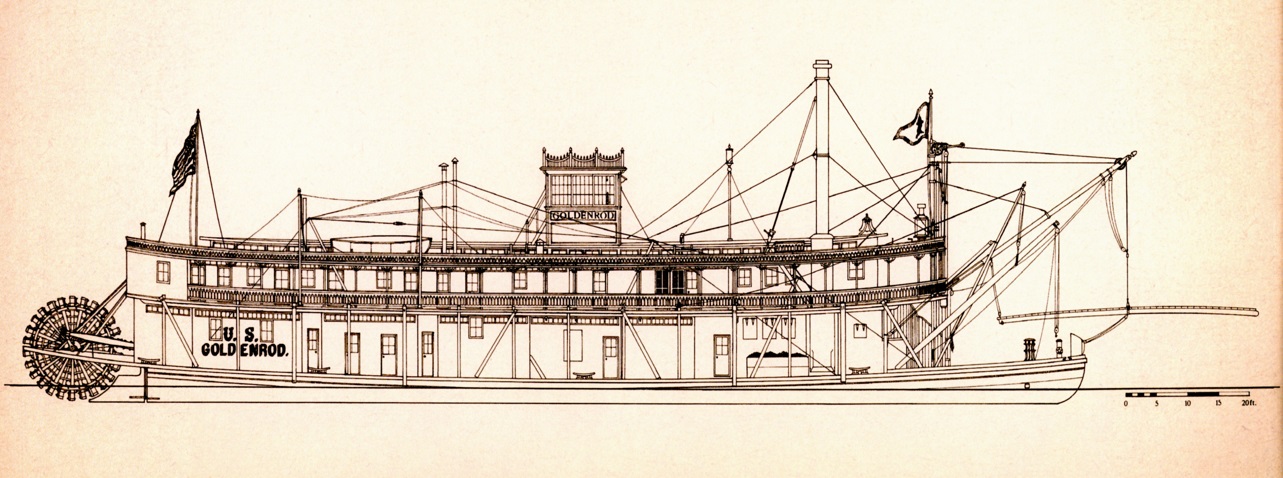
Lighthouse tender GOLDENROD starboard elevation
draughtsman's profile drawing of the U.S. Coast Guard Lighthouse Tender GOLDENROD.
Prints aavailable in various sizes from Fineart America
StockPhotosArt.com
Number FNART-1740170-1
The GREENBRIER has more than enough photos to qualify for its own page, with the rest including the GOLDENROD on "Other Tenders" - would be nice to find more GOLDENROD Images, great looking steamboat.
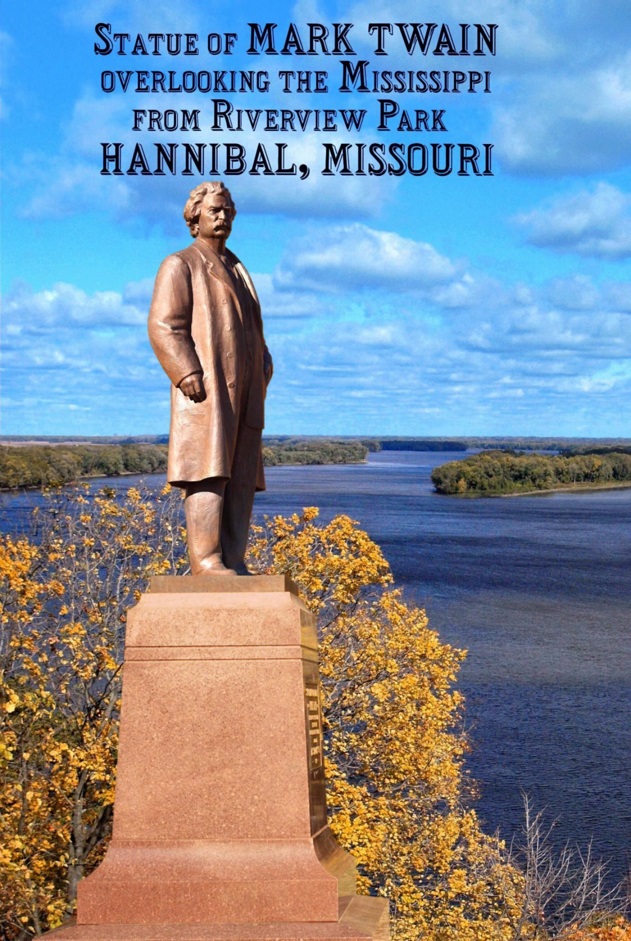
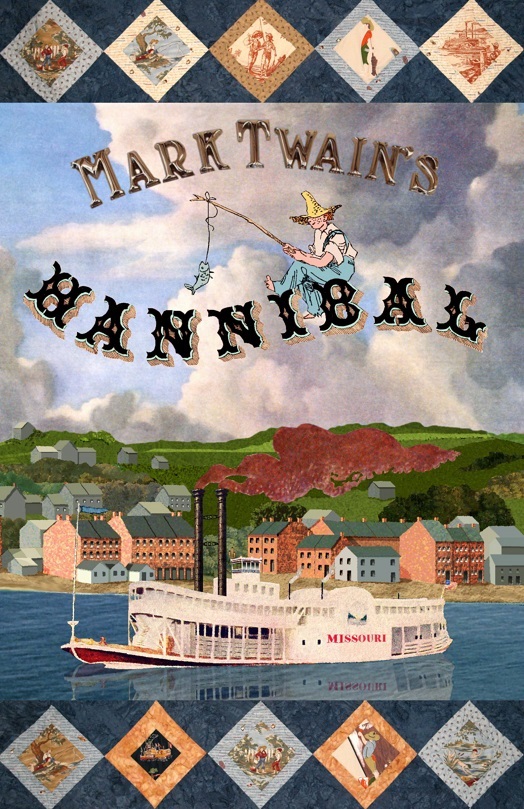
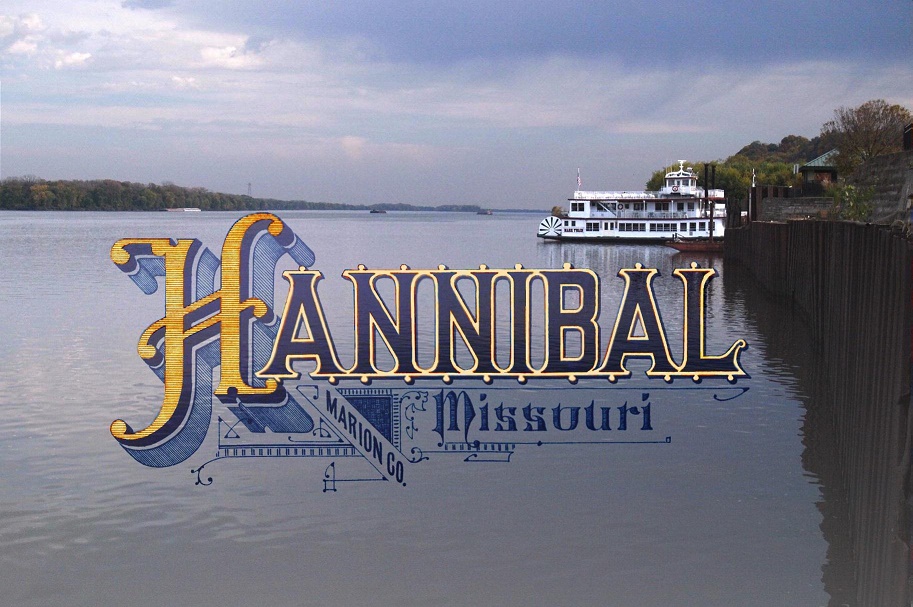
Three custom post card designs by Cap'n Dave
Attached scans of some of other post card designs that I've been making for merchandising in Hannibal. The Hagoods' grandson in law, Barry Messer had been using some of my photos on post cards for years which inspired me to come up with my own custom renditions with photos I had taken long ago and lettering from old maps circa 1854 and 1895 plus the license plate "topper" which I had chrome plated and from which I got the words "Mark Twain's" from. Barry had all the attached printed by Vista Print and they're at the BP convenience store on Mark Twain Avenue that is managed by "Janna" whose last name I don't know. I covered the printing costs of the cards.
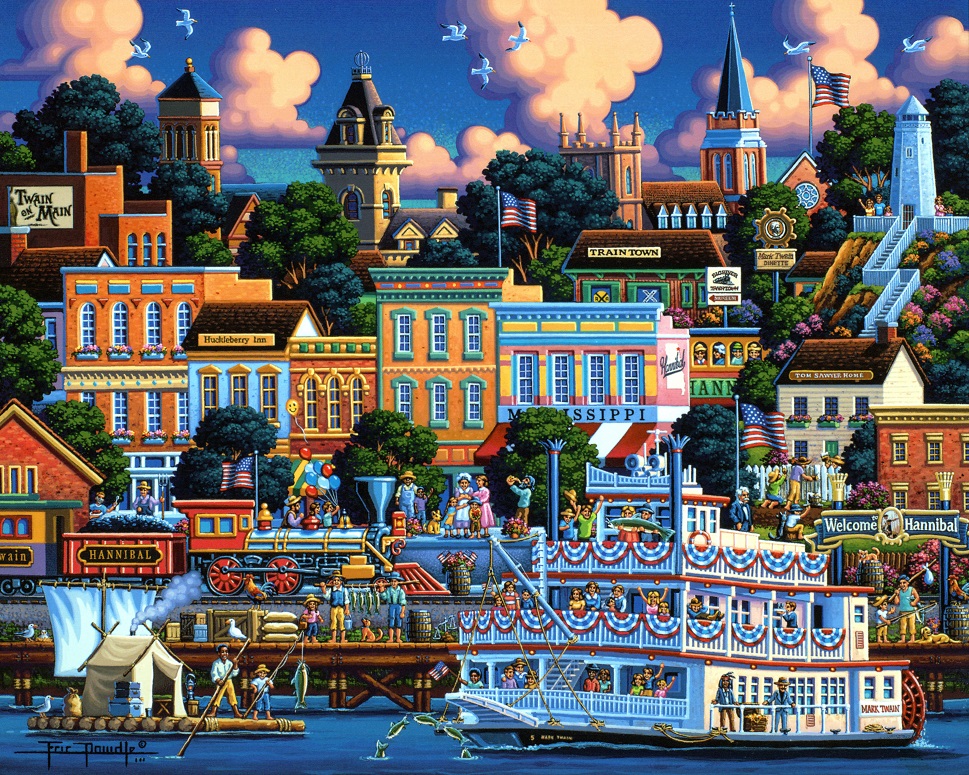
Eric Dowdle's fantasy painting representing Hannibal, Missouri. The artist compressed this but recognize many landmarks that residents and visitors will recognize in this idealized rendition of a nostalgic rivertown.
Dowdle has also painted many other towns and cities in the U.S.A. and in foreign countries around the world.
Eric Dowdle folk artist
Dowdle Folk Art (Gallery)
1280 W 200 S
Lindon, Utah 84042
Eric has been creating art for over twenty years. He started painting in his early twenties, parting ways with college after one year, to "go make something happen". Making things happen is how Eric does things; painting, exploring, marketing, and working day and night to expand the business, and his collection of over 200 paintings. Today, his work is distributed throughout the world. His painting research travel has taken him everywhere, from Kenya and China to the South Pacific and Europe.
Despite all of this, Eric's heart is in Utah. His favorite location is his Utah home, where his wife and five children busily run a mini-farm of 100 chickens, 7 peacocks, a bunny and two barn cats. He has a vast collection of Utah paintings that were published into a book in 2006.
Eric's upbringing started in rural Idaho on his family's farm. He is the tenth of twelve children—ten of which are sturdy boys. Many of the stories of his youth are reflected in his art—a chicken stuffed in a mailbox, a young boy surprising his mom with flowers from the neighbor's yard, children bravely walking a fence line, or Boy Scouts playing pranks on each other.
The Dowdle family moved from Idaho to Wyoming when he was ten years old. After his graduation, Eric's family moved to Massachusetts. It was there that he found a deep love for folk art. These early travels strongly contributed to Eric's love of culture and adventure.
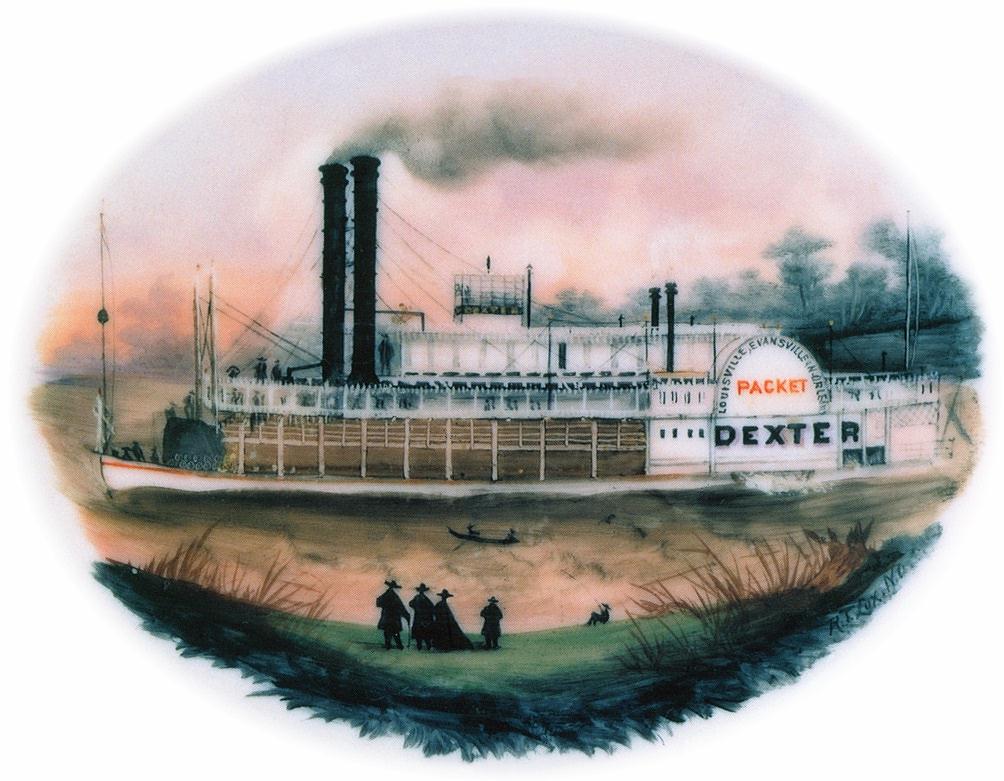
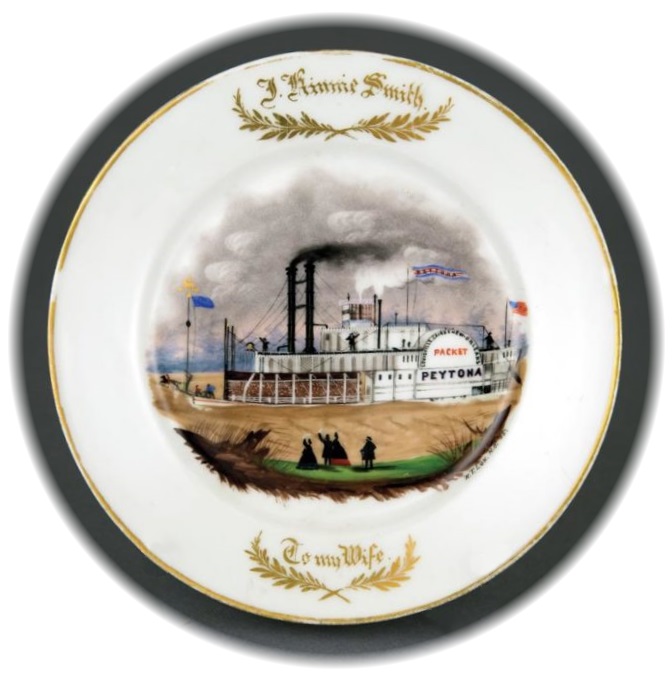
Steamboats DEXTER & PEYTONA painted on China plates by Rudolph Theodor Lux
Steamboat DEXTER 1868 - 1874 painted on a China plate by New Orleans artist Rudolph Theodor Lux. This is a detail from the color photograph of the plate on the cover of the Minneapolis Institute of Arts catalogue for the exhibition CURRENTS OF CHANGE - "Art and Life Along the Mississippi River 1850-1861."
Lux's 1865 painted plate of the steamboat PEYTONA 1859-1861 is from the Historic New Orleans Collection.
askart.com
Rudolph Lux was active in New Orleans from 1856 to 1858 and was considered to have been the premier porcelain painter and gilder working in New Orleans in the mid 19th century. He was born in Germany, and specialized in portraying prominent persons including Civil War figures on porcelain plates and cups.
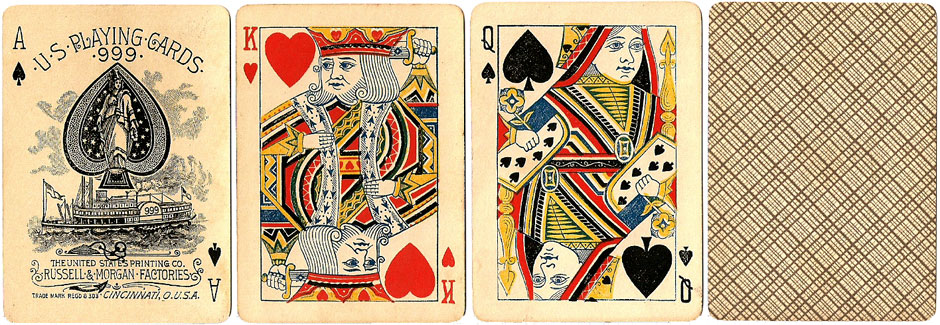
The Steamboat Brand
Posted by Simon Wintle - February 28, 2013
FROM THE SITE: "THE WORLD OF PLAYING CARDS"
wopc.co.uk
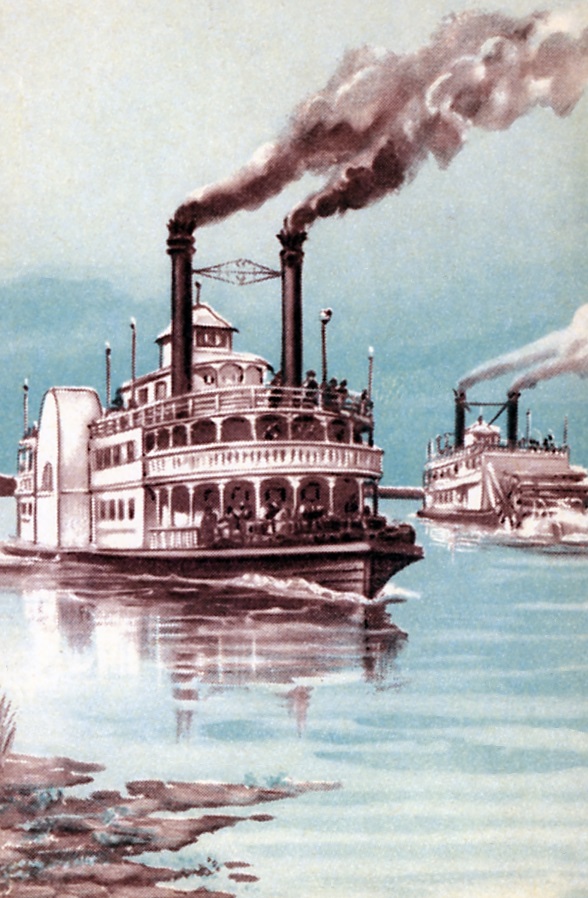
ILLUSTRATION OF A SIDEWHEELER & A STERNWHEELER FROM A DECK OF PLAYING CARDS
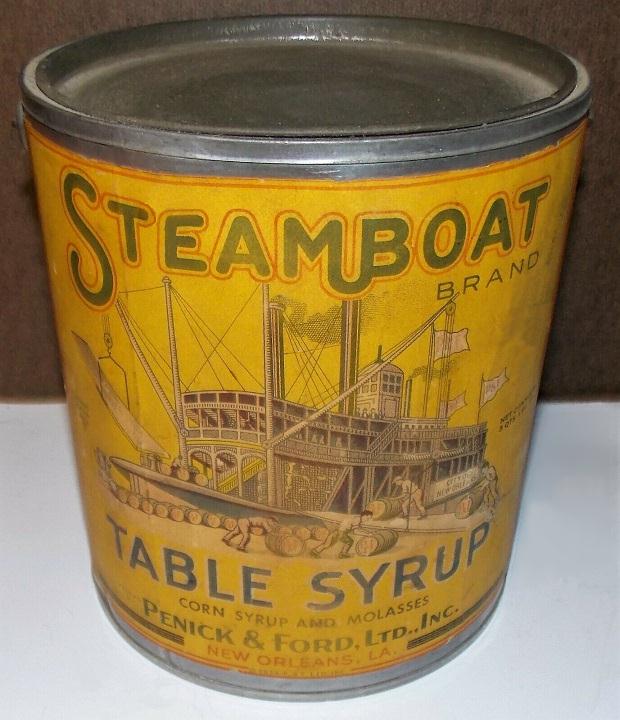
STEAMBOAT BRAND TABLE SYRUP Corn Syrup & Molasses
PENICK & FORD, LTD.,INC.
NEW ORLEANS, LA
3 Quarts Snap Lid Can
This was listed on eBay and I bid on it but it disappeared without a trace so the seller may have pulled it before close of auction. The were some flaws where lettering was torn that I was able to repair digitally.
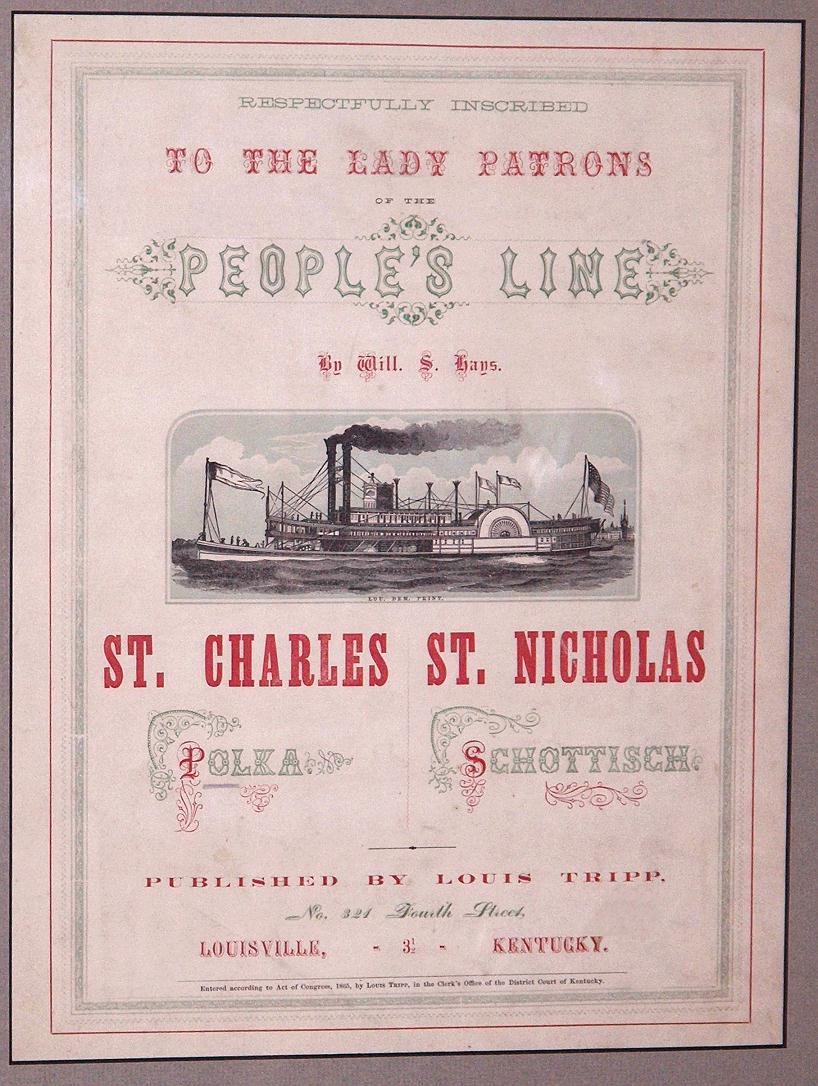
Sheet Music Will S. Hays : St. Charles POLKA & St. Nicholas SCHOTTISCHE 1865
"Two for the price of One"
RESPECTFULLY INSCRIBED
TO THE LADY PATRONS OFTHE PEOPLE'S LINE
By Will S. Hays
ST. CHARLES POLKA
ST. NICHOLAS SCHOTTISCH
PUBLISHED BY LOUIS TRIPP
No. 324 Fourth Street
LOUISVILLE ~ 3-1/2 ~ KENTUCKY
PUBLISHED IN 1865
ST. CHARLES
Way's Packet Directory Number 4916
Sidewheel packet built at New Albany, Indiana in 1864
764 tons 285 x 40 x 6 5 Engines, 24 's-8 ft Seven boilers
Capt Jesse K Bell formed the Peoples Line and ran this boat and WILD WAGONER in the Louisville-Cincinnati trade in opposition to theU.S. Mail Line.
Collided with MAJOR ANDERSON on Dec 12th,1865, at Coopers Bar, piloted by Napoleon B. Jenkins.
On Aug 6th, 1866, was racing with GENERAL LYTLE at Bethlehem, Indiana when the latter exploded.
The Peoples Line quit, and ST. CHARLES was sold at public auction at Cincinnati November 1866 to Thomas Gaylord for $50,000, only bidder.
In mid-February 1867 Captain Hugh Campbell became master and she ran Louisville-New Orleans.
Entered Pittsburgh-Cincinnati trade, Captain Charles A Dravo, with Andy Robinson, Jr. in the office, March 1868 and ran until latter June when low water stopped her.
Resumed in latter September same master, with George L. Reppart, Henry Chapin, and J.M. Lovett in the office, piloted by Ben Hall and Joe Witten, and with Joe Dodson, steward.
Immediately after the UNITED STATES collided with the AMERICA she was chartered by the U.S. Mail Line Co , for the Louisville-Cincinnati trade and so continued until December 1869.
During this term of charter she attempted a race with the ROB'T E. LEE, upbound at Madison, April 4th, 1869, and was quickly vanquished.
Resumed Pittsburgh-Cincinnati trade December 1869, Captain Charles A. Dravo, with George L. Reppart, first clerk, and with James Rowley and C.C. Cable, pilots.
Sank at Duff's Bar after striking a rock, near Dixmont, Pennsylvania, at Neville Island, Feb 11th, 1871, downbound, pilot Ben Hall on watch.
She was raised within a week and went to the marine ways at Cincinnati.
Resumed and ran until latter April when, upbound, she broke hull timbers in Sisters Islands, the river low, and she couldn't get through Glass House Ripple at Brunot's Island, and the D. T LANE brought flats and took her freight to Pittsburgh Resumed in the fall and got frozen in at Safe Harbor, Pa., in late December Burned at Cincinnati March 7th, 1872, along with the MAJOR ANDERSON and others.
There is evidence she was shorter than the dimensions given m this account when originally built, and was lengthened at Madison, Indiana by the People's Line, circa1866.
ST. NICHOLAS
Way's Packet Directory Number 4962
Sidewheel packet built at New Albany, Indiana in 1864.
669 tons 223 3x33 8 x 3 7 Engines, 22's-7 ft Seven boilers.
Launched June 6, 1864, at the J. B. Ford yard in front of the American Foundry.
Owned by Cincinnati New Orleans Packet Co , with David Gibson a majority owner.
Made trips above Cincinnati early 1866, Capt Enos Moore.
Enrolled at New Orleans April 1866 owned by David Gibson (8/12) and her master Capt Sosthene Heno, and her clerk John Corne Libano.
Ran New Orleans-Bayou Sara. In January 1867 owned entire by David Gibson, with Capt J. C. Dowty, master.
Ran New Orleans-Red River.
Sank in full view of Natchitoches, Louisiana, Dec 23rd, 1868, and sat there on the bottom, straight and even all that winter. A flood in May 1869 took off the cabin, texas, and pilothouse. Captain John C. Dowty chartered the STONEWALL to take her place and lost his life when that boat burned on Oct 27th, 1869.
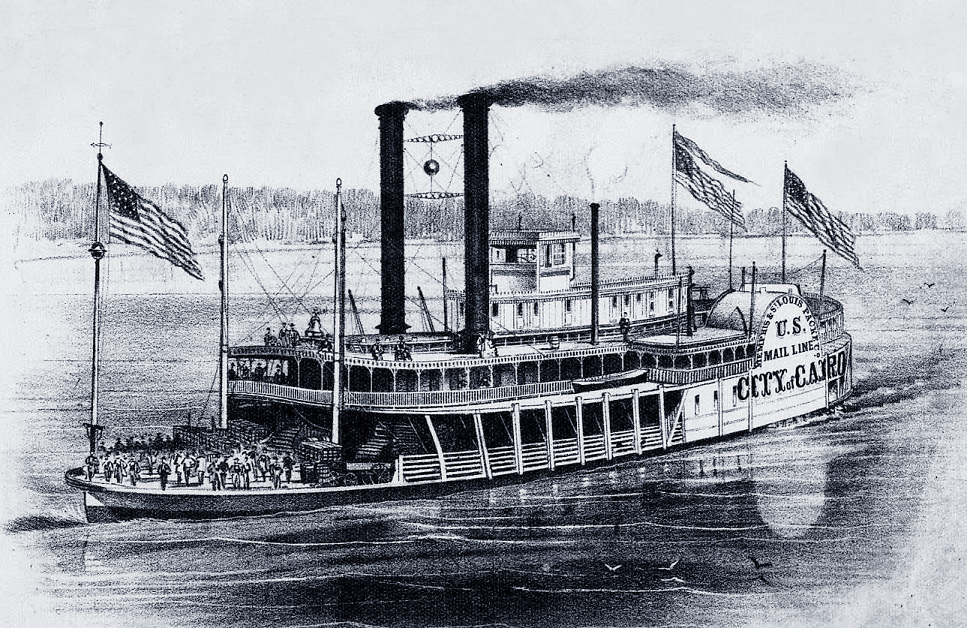
Lithograph by McClean of steamboat CITY OF CAIRO
from the sheet music cover for
THE CITY OF CAIRO SCHOTTISH
Composed for the Piano by Chas. J. Young
Published by R.J. Compton
52 4th Street, St. Louis, MO
The CITY OF CAIRO was owned by the Memphis & St. Louis Packet Co., launched in 1864, ran between St. Louis, Memphis and New Orleans where she was lost in a fire on 7th of July, 1873.
Captain Robert K. Riley was in command of the CAIRO beginning in 1864.A U.S. Marshal seized the CAIRO at the request of creditors who demanded reimbursement for their investment in the boat and it was sold at a Marshal's sale for $2,100 on 23rd of June, 1873.
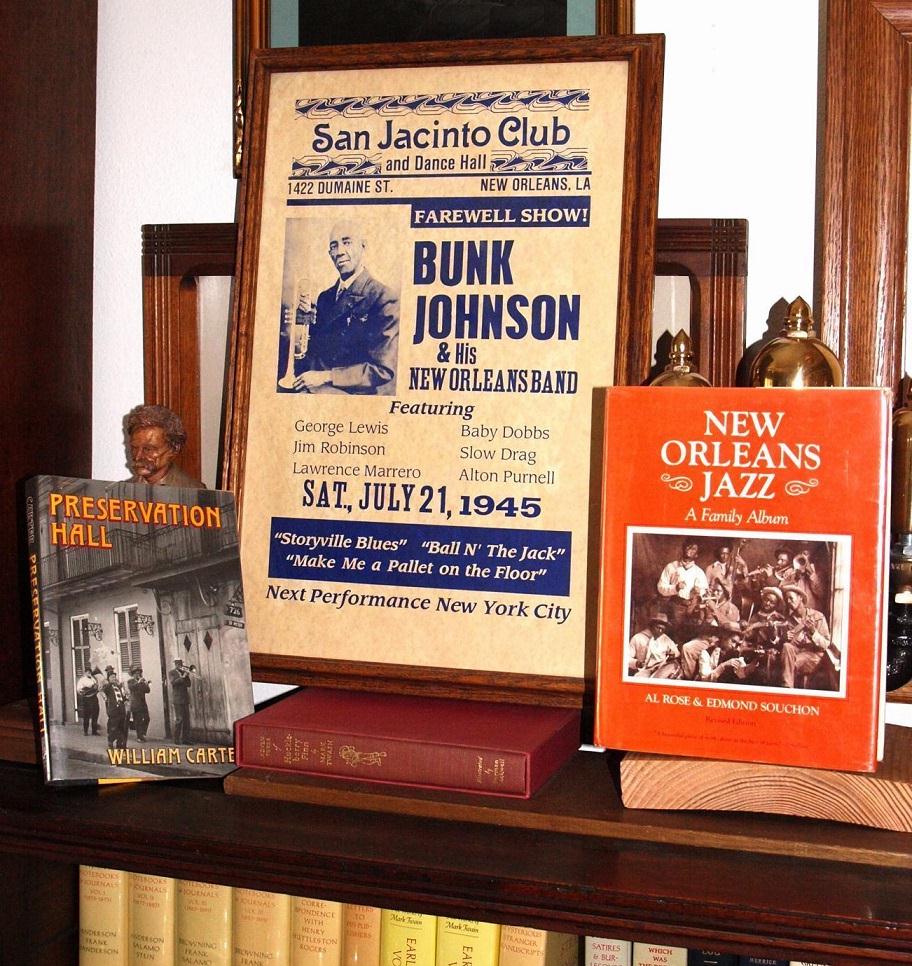
On the top of a book case in my River Room, New Orleans Jazz poster and 2 books. My brother and I attended a performance given by jazz musicians in Preservation Hall in New Orelans in October, 1989:
Framed BUNK JOHNSON & His New Orleans Band poster for San Jacinto Club & Dance Hall, New Orleans Farewell Show Saturday 21 July, 1945
2 books: PRESERVATION HALL by William Carter And NEW ORLEANS JAZZ A Family Album by Al Rose and Edmond Souchon
from Wikipedia:
Willie Gary "Bunk" Johnson (December 27, 1879 - July 7, 1949) was a prominent jazz trumpeter in New Orleans. Johnson gave the year of his birth as 1879, although there is speculation that he may have been younger by as much as a decade.
Johnson received lessons from Adam Olivier and began playing professionally in Olivier's orchestra. Johnson probably played a few adolescent jobs with Buddy Bolden, but was not a regular member of Bolden's Band (contrary to Johnson's claim). Johnson was regarded as one of the top trumpeters in New Orleans in the years 1905-1915, in between repeatedly leaving the city to tour with minstrel shows and circus bands.
After he failed to appear for a New Orleans Mardi Gras parade job in 1915, he learned that krewe members intended to do him bodily harm. So he left town, touring with shows and then by the early 1920s settling in New Iberia, Louisiana.
In 1931 he lost his trumpet and front teeth when a fight broke out at a dance in Rayne, Louisiana, putting an end to his playing. He thereafter worked in manual labor, occasionally giving music lessons.
In 1938 and 1939 the writers of an early book of jazz history, Jazzmen, interviewed several prominent musicians of the time, including Louis Armstrong, Sidney Bechet, and Clarence Williams, who spoke highly of Johnson in the old days in New Orleans. The writers tracked down Johnson's address, and traded several letters with him, where he recalled (and possibly embellished) his early career. Johnson stated that he could play again if he only had new teeth and a new trumpet. A collection was taken up by writers and musicians, and he was fitted with a set of dentures by Bechet's dentist brother, Leonard, and given a new trumpet. He made his first recordings in 1942, for Jazz Man Records.
These first recordings propelled Johnson (along with clarinetist George Lewis) into public attention, attracting a cult following. Johnson and his band played in New Orleans, San Francisco, Boston, and New York City and made many more recordings. Johnson's work in the 1940s shows why he was well regarded by his fellow musicians—on his best days playing with great imagination, subtlety, and beauty—as well as suggesting why he had not achieved fame earlier, for he was unpredictable, temperamental, with a passive-aggressive streak and a fondness for drinking alcohol to the point of impairment.
Johnson suffered from a stroke in late 1948 and died in New Iberia the following year. Jazz fans and historians still debate Johnson's legacy, and the extent to which his colorful reminiscences of his early career were accurate, misremembered, exaggerated, or untrue. Although in recent years, new evidence has appeared in jazz historian Vic Hobson's 2014 Creating Jazz Counterpoint. New Orleans, Barbershop Harmony, and the Blues, in which is stated that Buddy Bolden's band member Willy Cornish - who is seen on the only surviving picture of the Bolden Band - affirmed Bunk Johnson as a member of the early jazz group. This puts Johnson's own statements and recordings, in which he actively recreated the Bolden tunes, in a plausible and positive light, making them of great historical and musicological importance to the study of jazz and New Orleans Jazz in particular.
The majority of his recordings remain in print on CD reissues, and his playing is an important influence on many contemporary traditional jazz musicians. Johnson plays a small, but significant, role in Alan Schroeder's picture book Satchmo's Blues. In that book, Johnson serves as a source of musical inspiration to the young Louis Armstrong.
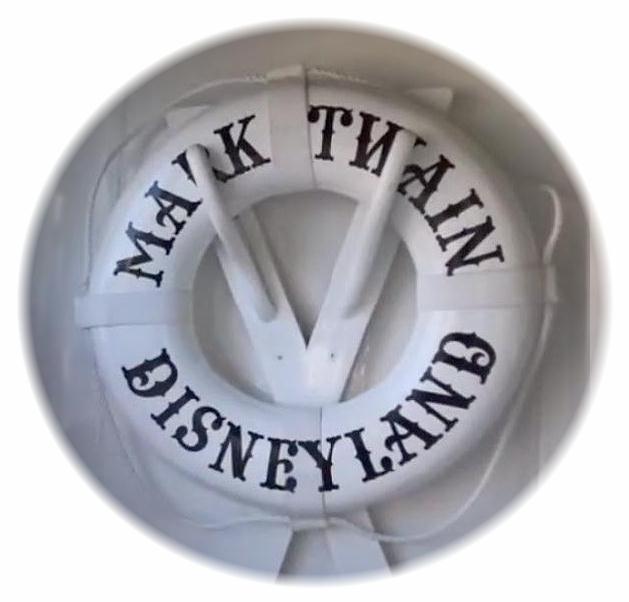
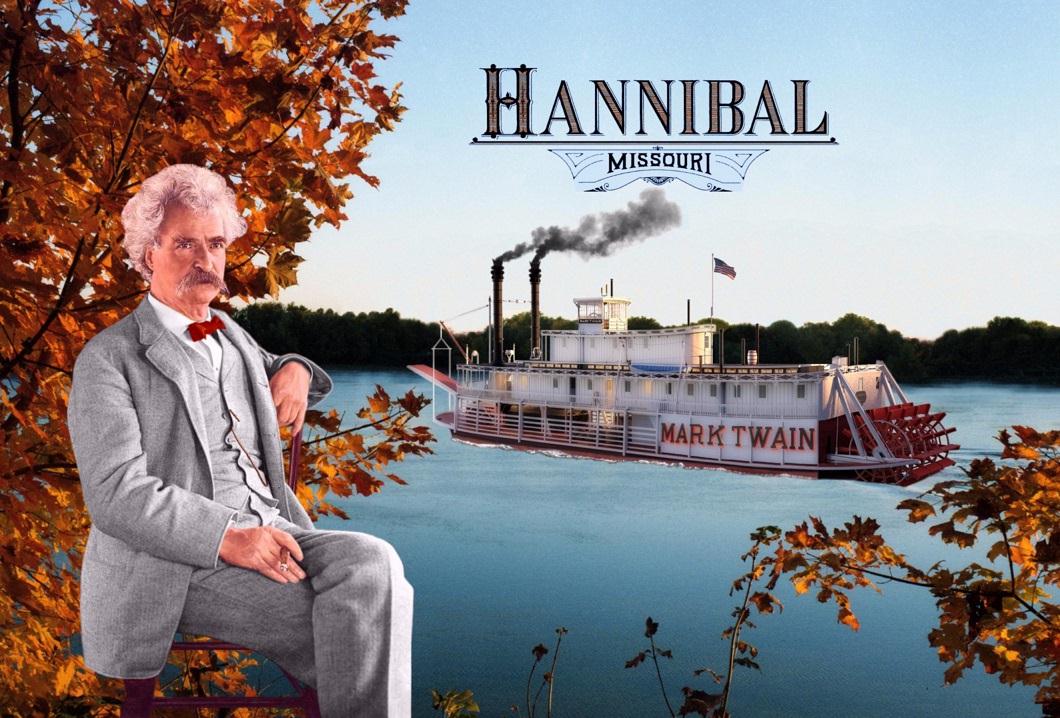
Clemens with Fall Colors on the Mississippi & a Steamboat custom made by Dave for a post card
